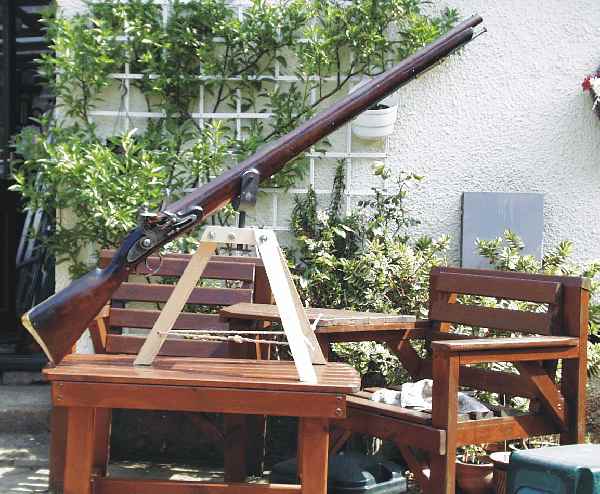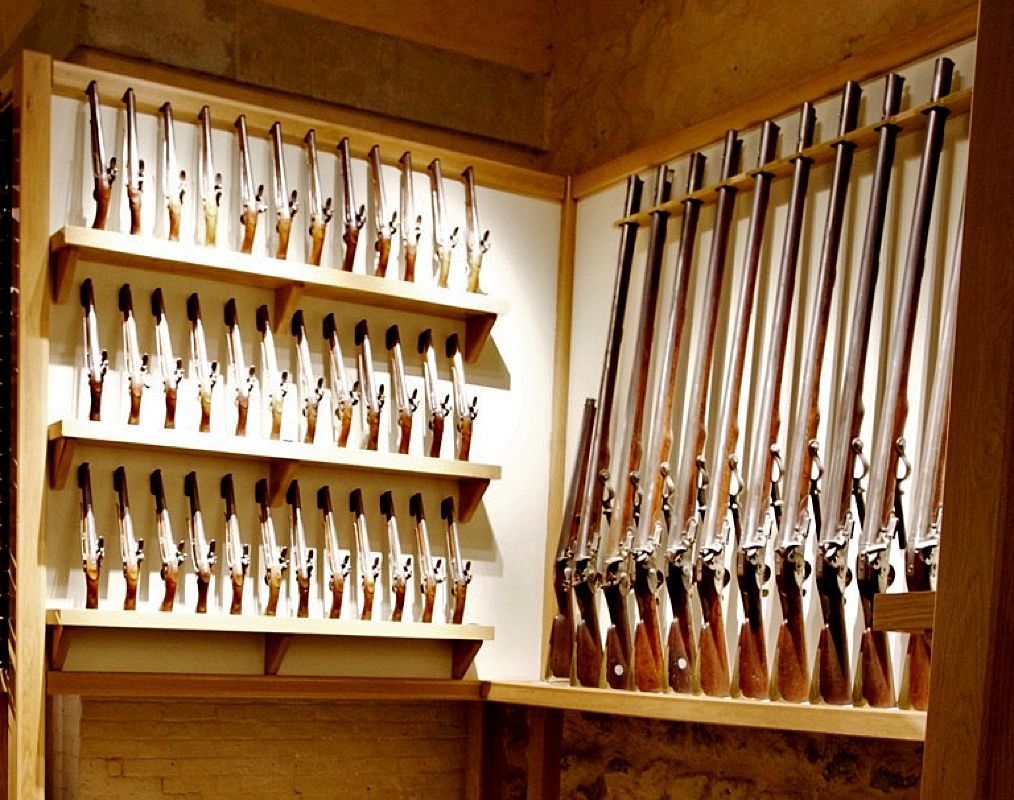Quite ironic, isn't it then .... that he was killed by such a shot fired from a musket up in the sails?Supercracker said:It was my understanding that the prohibition of marines in the tops was a result of one of Lord Nelsons peculiar fears and thus didn't become the norm til after he rose to prominence.
-
This community needs YOUR help today. We rely 100% on Supporting Memberships to fund our efforts. With the ever increasing fees of everything, we need help. We need more Supporting Members, today. Please invest back into this community. I will ship a few decals too in addition to all the account perks you get.

Sign up here: https://www.muzzleloadingforum.com/account/upgrades -
Friends, our 2nd Amendment rights are always under attack and the NRA has been a constant for decades in helping fight that fight.
We have partnered with the NRA to offer you a discount on membership and Muzzleloading Forum gets a small percentage too of each membership, so you are supporting both the NRA and us.
Use this link to sign up please; https://membership.nra.org/recruiters/join/XR045103
You are using an out of date browser. It may not display this or other websites correctly.
You should upgrade or use an alternative browser.
You should upgrade or use an alternative browser.
Ships Weapons
- Thread starter Supercracker
- Start date

Help Support Muzzleloading Forum:
This site may earn a commission from merchant affiliate
links, including eBay, Amazon, and others.
robinghewitt
62 Cal.
- Joined
- Jun 26, 2004
- Messages
- 2,605
- Reaction score
- 19
Mick C said:hotoSmile: Please!!
Civilian wall gun c1780, probably off a ship. 64" overall, 28 lbs :thumbsup:

BCarp
40 Cal.
- Joined
- Oct 30, 2004
- Messages
- 225
- Reaction score
- 103
Great book on the topic:
http://www.amazon.com/Sea-Rovers-P...9350&sr=1-1&keywords=the+sea+rover's+practice
Pirates and privateers often relied upon heavy musket fire to blanket a merchantman's small crew into submission, rather than pounding her with the "great guns" - which could seriously damage the valuable prize. Most victims surrendered without a fight anyways. Long-barreled muskets of the "buccaneer" type were favored for such work, with pistols and blunderbusses useful for the close-in fighting of actual boarding actions.
Pirates and privateers often relied upon heavy musket fire to blanket a merchantman's small crew into submission, rather than pounding her with the "great guns" - which could seriously damage the valuable prize. Most victims surrendered without a fight anyways. Long-barreled muskets of the "buccaneer" type were favored for such work, with pistols and blunderbusses useful for the close-in fighting of actual boarding actions.
Last edited by a moderator:
Although we see pirates fighting it out, broad side to broad side, falling mast and blood running from the scuppers. The reality was that an armed fast moving ship would take a position to the wind and aft of chase. The threat was clear and chase usually struck with out a shot being fired. There were fights for sure but they were very rare. It was hard to hire men to risk their life's for low pay of a sailor, and almost as hard to find many willing to die to take a treasure. Dead men tell no tale, also they don't spend much "plumb".
Don't forget boarding axes and a sturdy cutlass.
:wink:
LD
:wink:
LD
Positively agree! My 17th C. Dutch cutlass...

Pretty practical for colonial American land service too says I -- arrggghhhh.
And then there's this to go with it...
http://www.muzzleloadingforum.com/fusionbb/showpost.php?post/1494186/

Pretty practical for colonial American land service too says I -- arrggghhhh.
And then there's this to go with it...
http://www.muzzleloadingforum.com/fusionbb/showpost.php?post/1494186/
Last edited by a moderator:
Looks fit to buckle a swash with :thumbsup:
robinghewitt
62 Cal.
- Joined
- Jun 26, 2004
- Messages
- 2,605
- Reaction score
- 19
Tex said:Nice looking pop-gun you have there Squire. What's the bore size? Can we get more close up pics? :wink:
The military pieces were 1" but this is a .96"
I heard that wall guns existed and shouted out, "I want one!" Shooting buddy Gordon said he knew where there was one for sale and I have not seen another since except for one on the Antiques Roadshow but that had lost about 3 feet off the end of the barrel.
This one has rusted up some time in the past and the ramrod must have got stuck. They drilled into the channel from above to loosen it, put a cold chisel on an exposed part and knocked it out :shocked2:
I can take any pictures you want but it's like the Grand Canyon, you have to be there to get the scale of things. In pictures it looks rather ordinary :thumbsup:
In November of 1755, Robert Rogers and 21 men had a set-to with French soldiers on the waters of Lake George. Rogers and his men were in two battoes, 7 men each, the French in two large canoes with 13 & 15 men. Part of the report of the engagement:
"One he ordered to keep that with 13 in Play, but by no Means let them come within Musket Shot. He went towards the one with 15; they had each a Wall piece or large Blunderbuss; they ply off and on, till Rogers taking his Opportunity, when their Broadside was towards him, fired his Wall piece."
Just coincidentally, my son is visiting London, and spent the day in the Tower of London. He sent pictures, one of which just happened to show a case with 10 swivel wall pieces and a blunderbuss.

Spence
"One he ordered to keep that with 13 in Play, but by no Means let them come within Musket Shot. He went towards the one with 15; they had each a Wall piece or large Blunderbuss; they ply off and on, till Rogers taking his Opportunity, when their Broadside was towards him, fired his Wall piece."
Just coincidentally, my son is visiting London, and spent the day in the Tower of London. He sent pictures, one of which just happened to show a case with 10 swivel wall pieces and a blunderbuss.

Spence
So these are a bit smaller than an amusette?
Cynthialee said:So these are a bit smaller than an amusette?
"About 50 pounds... could fire a 4 ounce or 1.2 inch shot." - U.S. Army Center of Military History
Thanks to all of you. :hatsoff: Excellent photos and discussion. A most interesting thread for my continuing education.
Well, Grumpa, if we've educated you, it's only fair to ask you to return the favor. Teach me why that amusette has a sliding wooden patch box. :wink:Grumpa said:Thanks to all of you. :hatsoff: Excellent photos and discussion. A most interesting thread for my continuing education.
Spence
:haha: Good question - that hadn't occurred to me!
Looking at the photo (enlarged) the patchbox cover looks to be of different wood than the stock? (I just discovered that the original was lost, and it was replaced years later by the Smithsonian.)
The patch box may have served the purpose it does on a longrifle. Or, perhaps it held a tool of some kind - or a small bottle of strong rum to fortify the man who had to fire such a gun. :grin:
According to the USACMH, it was made at Rappahannock Forge at the direction of the Virginia government, about 1777. But, other than commenting that the gun has a sliding wooden patch box cover, the article makes no mention of its purpose.
Convention? (These guns show influence from the early Germanic style). (And such a cover on a fixed mount gun did not present the problem of loss that it would on a smaller, portable rifle.) No corrosion problem from salt air exposure (as opposed to brass or iron)?
I have been searching for an answer to your question, but I'm just guessing. You folks are the ones more knowledgeable than I ...I suspect that I will be enlightened shortly.
Looking at the photo (enlarged) the patchbox cover looks to be of different wood than the stock? (I just discovered that the original was lost, and it was replaced years later by the Smithsonian.)
The patch box may have served the purpose it does on a longrifle. Or, perhaps it held a tool of some kind - or a small bottle of strong rum to fortify the man who had to fire such a gun. :grin:
According to the USACMH, it was made at Rappahannock Forge at the direction of the Virginia government, about 1777. But, other than commenting that the gun has a sliding wooden patch box cover, the article makes no mention of its purpose.
Convention? (These guns show influence from the early Germanic style). (And such a cover on a fixed mount gun did not present the problem of loss that it would on a smaller, portable rifle.) No corrosion problem from salt air exposure (as opposed to brass or iron)?
I have been searching for an answer to your question, but I'm just guessing. You folks are the ones more knowledgeable than I ...I suspect that I will be enlightened shortly.
Not by me, and I'm guessing that if you flunk, we all flunk. :haha:Grumpa said:You folks are the ones more knowledgeable than I ...I suspect that I will be enlightened shortly.
Spence
My bad! :redface: That bottle would have held WHISKY during the AWI. :grin: An oversight on my part, slighting my favorite libation. Though I do enjoy a nice rum, it would not have been readily available, due to the British blockade.
And American-made whisky/whiskey had become the patriotic drink.
And American-made whisky/whiskey had become the patriotic drink.
robinghewitt
62 Cal.
- Joined
- Jun 26, 2004
- Messages
- 2,605
- Reaction score
- 19
George said:Teach me why that amusette has a sliding wooden patch box. :wink:
Sliding wooden patch box? Is there a picture of an amusette that I cannot see? Not fair, where is it? :idunno:
Similar threads
- Replies
- 69
- Views
- 3K
- Replies
- 9
- Views
- 684



